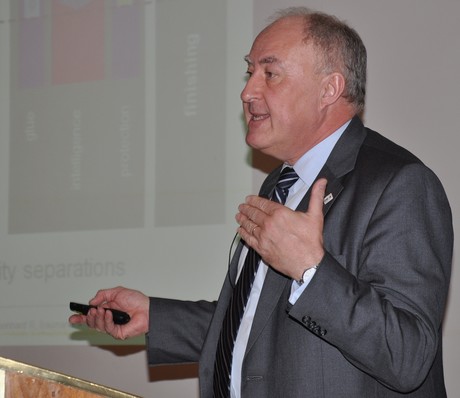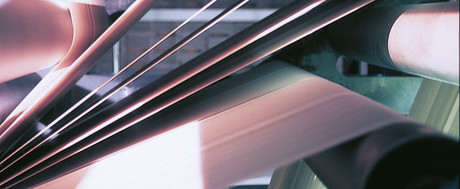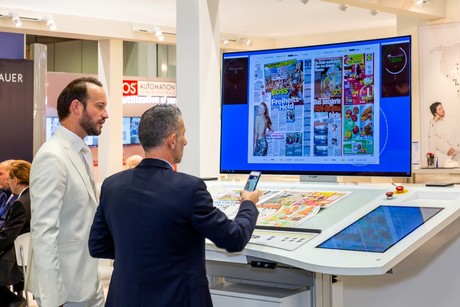Visions, i.e. ideas that describe desirable future conditions, can give our decisions direction and thus help provide long-term orientation for our everyday business, which all too often has a short-term focus.
Anybody who must make decisions on newspaper production technology does so from a long-term perspective. A printing press must not only be fit for use over many years, but also efficiently produce “state-of-the-art” quality throughout its lifetime.
Phillip Crawley, the publisher and CEO of the Toronto, Canada-based national newspaper The Globe and Mail, has developed a clear vision of the newspaper of the future. The paper’s relaunch in autumn 2010 had the following objectives:
- Revival of the market-leading newspaper
- Expression of confidence in print as the core element of a multi-platform offering
- Utilisation of the technical possibilities offered by the new printing presses
- Implementation of a new content strategy and introduction of an innovative new design
- Introduction of the new Life and Style newspaper sections
- Attraction of new advertisers
- Execution of a new brand marketing campaign
The outcome was to make the newspaper a truly high-quality information medium. Thanks to a new level of quality achieved through a combination of coldset and heatset printing on coated paper, together with its sophisticated design and presentation, it becomes attractive also for those advertisers who previously advertised only in glossy magazines.
Not just publishers but also printers develop visions of the future of newspaper printing. For many, the objective is to transform the newspaper into a profit centre that acts independently on the market. There are various approaches to that objective that can either lead to more independence from the publishing house and/or, by acting in close cooperation with the latter, to continuous expansion of the range of services offered and therefore greater profitability.
IFRA Expo 2011 in Vienna surprisingly unveiled an unusually wide variety of technical innovations in the area of newspaper production. Very few people in the industry expected five press models (including two ink-jet-based) to be unveiled there that had not existed just a year before at IFRA Expo in Hamburg.
Although the market as a whole is getting smaller, that by no means indicates that customers are lowering their demands and expectations. Newspapers in Europe and Japan are investing in automation primarily to simplify and shorten work processes and reduce manning requirements. So-called closed loop systems play a major role here, i.e. systems that control presses or certain functions of presses in real time and keep them stable. These include colour register and colour density, and also automatic control of web tension and cylinder impression pressure. In addition, all systems that simplify and accelerate job change-over are of major interest (especially to European printing operations). These include systems that optimise “just-in-time” plate production, sort the plates as required, transport them automatically to the press and finally carry out plate changes automatically and very quickly, and also suitably dispose of the used plates or put them into storage for later re-use.
A type of automation that was put into practice many years ago in Japan is becoming increasingly important in Europe as well, especially in large printing centres: automatic paper logistics. This covers the entire process from ordering the reel to running it in the press, up to and including entering the reel stubs into the recycling process.
Will these currently discernible trends in newspaper production become established in the long term and on a wide scale? Will the development of highly automated and highly complex systems dominate in the long term, or will they give way to a counter-trend towards a “simple newspaper press”? When and how will digital printing become an option for newspaper production outside of the short-run niche? Which transitional and mixed forms of offset and ink-jet printing are conceivable? How will social media and bridge technologies between print and digital, such as ”augmented reality,” e-ink, OLED, RFID and NFC, influence the newspaper of the future?
Finally, the question arises as to why the “newspaper factory” must deal with so many different transport systems for the various materials and unfinished products and the corresponding interfaces. Shouldn’t it be possible to consider the entire production chain from the transport aspect and develop a standard, flexible system for all transport tasks that offers better capacity utilisation and requires less space and investment of capital resources?
The newspaper market is changing. Publishers and press manufacturers cannot afford to sit on the fence, but instead must think ahead, act proactively, develop business models and test new techniques. Anyone who wants to influence the market in his favour needs marketing and a strong sales force, something that newspaper printing operations did not have in the past. Could it be that publishing houses and printing companies need some tutoring?
Perhaps it would be a good idea simply to ask more young people what they expect from their newspapers. The future will be their domain and the newspaper should also be their medium.
We will explore the various aspects of newspaper technology and the future of the newspaper in our “Future Press” series of articles, in which we will present technical developments and their application in the context of a vision of the future of the printed newspaper.








